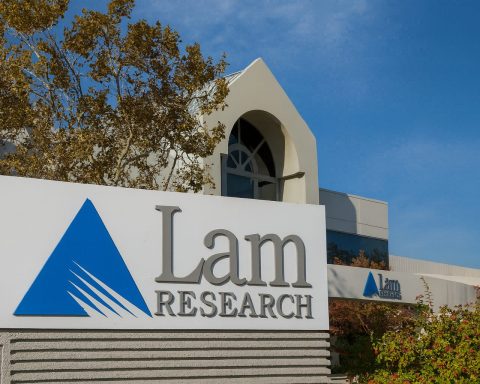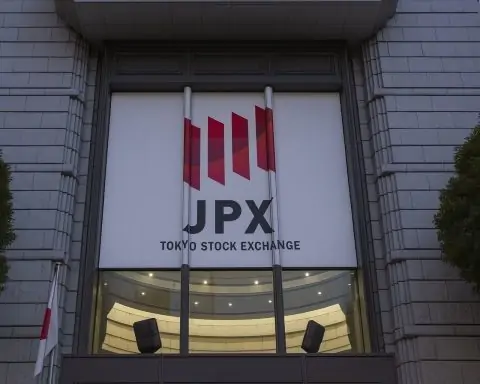- On August 12, 2025, Nasdaq Composite and S&P 500 closed at record highs as AI stocks drove gains and cooling inflation boosted expectations for a Fed rate cut.
- Nvidia (NVDA) surged to an intraday high of about $184.50 on August 12 and closed near $183, pushing its market cap toward $4.5 trillion.
- The U.S.–China export deal allowed Nvidia and AMD to resume selling advanced AI chips to China with a 15% revenue share to the U.S. government in exchange for export licenses.
- Perplexity AI offered $34.5 billion in cash to buy Google’s Chrome browser, sending Alphabet (GOOGL) shares up roughly 1.2%.
- SoundHound AI (SOUN) reported Q2 revenue of $42.7 million, up 217% year over year, narrowed its loss, and raised its full-year outlook, with the stock rallying about 43% from Aug 8–11.
- C3.ai (AI) pre-announced Q1 revenue near $70 million, well below its guidance of $100–109 million, triggering a ~25% drop on August 11 and a more than 50% decline for 2025.
- Palantir Technologies (PLTR) posted Aug 7 results with revenue up 48% to over $1 billion, raised full-year guidance, announced its first stock buyback, and traded near $188 with a market cap above $440 billion on August 12.
- BigBear.ai (BBAI) reported Q2 revenue down 18% and a larger-than-expected loss, causing about a 20% after-hours slide on August 11 and continued weakness on August 12.
- Japan’s Nikkei 225 jumped 2.2% to 42,718 on August 12, with SoftBank Group rising 6.9% to a new historic high and augmenting weekly gains by more than 25%.
- Rumble revealed it is exploring a roughly $1.17 billion bid for Germany’s Northern Data, which owns about 20,000 high-end Nvidia GPUs, potentially securing a large AI computing footprint if approved.
Introduction: A Whirlwind 48 Hours for AI-Focused Markets
In the past two days, AI-related stocks have surged to new heights, helping drive major indices to record highs – even as cracks of caution emerged. Tech giants basked in post-earnings momentum and optimism around artificial intelligence (AI), while investors cheered blockbuster deals and bold strategic moves. At the same time, geopolitical cross-currents (from Washington’s export curbs to Beijing’s pushback) injected a note of uncertainty. Below is a comprehensive roundup of all the major AI stock news from August 12–13, 2025 – including soaring share prices, key announcements, market reactions, expert quotes, and broader sector implications.
Record Highs as Tech Titans Ride the AI Wave
Wall Street’s Nasdaq Composite and S&P 500 both notched record closing highs on Tuesday, Aug. 12, fueled in part by enthusiasm for AI-driven tech leaders [1] [2]. Cooling inflation data boosted hopes of an imminent Fed rate cut, adding fuel to the tech rally [3] [4]. Mega-cap players Microsoft and Alphabet (Google) traded near recent highs, reflecting strong Q2 results that were powered by cloud and AI demand [5] [6]. Analysts continue to view these giants as stable winners from the AI boom – for example, Wedbush Securities recently called Microsoft and Google “AI front-runners” with durable moats in a crowded field [7]. Both stocks held steady over the past two days, suggesting that much of their good AI news was already priced in after earnings.
Alphabet actually got an extra bump from an unusual source: Perplexity AI, a startup, made a surprise $34.5 billion cash offer to buy Google’s Chrome web browser [8] [9]. While the bid’s chances are dubious, it grabbed headlines – Alphabet’s shares rose about 1.2% on the development [10] [11]. The move underscores how even upstart AI firms are growing bold in challenging tech titans. Meanwhile Amazon and Meta Platforms also traded near 52-week highs amid their own AI initiatives. Meta has been aggressively investing in AI talent – it reportedly acquired or is close to acquiring multiple AI startups (e.g. voice-tech firms PlayAI and WaveForms) to boost its conversational AI capabilities [12] [13]. These kinds of bets have kept Meta’s stock hovering near yearly peaks, though no major new Meta-specific news hit in the last two days. Overall, the “Magnificent 7” tech cohort – from Apple to Nvidia – remains the market’s cornerstone, with fund manager surveys naming these AI-centric giants as the most “crowded trade” of 2025 [14]. Their sheer scale and stable growth mean they continue to grind higher, even as investors also seek more explosive gains in smaller AI names.
Chipmakers Rally on AI Demand – and Navigate Geopolitical Cross-Currents
Semiconductor stocks – at the heart of the AI revolution – extended their rally into this week, outpacing the broader market [15]. Multiple catalysts powered this surge:
- U.S.–China Export Deal:Nvidia (NVDA) and Advanced Micro Devices (AMD) struck an unusual agreement with Washington to resume selling advanced AI chips to China – but at a price. The companies agreed to give the U.S. government a 15% cut of revenue from any China sales of high-end AI chips, in exchange for export licenses [16] [17]. The White House on Tuesday confirmed the arrangement and suggested “perhaps it could expand… to other companies” over time [18]. Investors cheered the resolution of this export standoff. Nvidia’s stock jumped to a fresh all-time high of ~$184.5 intraday on Aug. 12 [19], and closed up 0.5% near $183, now boasting a staggering ~$4.5 trillion market cap. AMD’s shares also gained ~1.6% on Tuesday [20], reflecting optimism that access to the huge China AI market (even with a revenue-sharing toll) will boost future sales. “We see this as a creative solution,” noted one analyst, as it allows Nvidia and AMD to keep tapping Chinese demand while assuaging U.S. security concerns through profit-sharing.
- China’s Caution on U.S. Chips: Even as U.S. policy softened, Beijing signaled new unease about American AI chips. Chinese regulators summoned tech giants – including Tencent, ByteDance, and Baidu – in recent weeks, questioning their purchases of Nvidia’s next-gen H20 AI chips and “expressed concerns” over data security [21] [22]. Officials pointedly asked why firms needed Nvidia’s hardware when domestic alternatives exist [23]. According to reports, some Chinese companies were even urged to avoid using the Nvidia H20, especially for government-related projects [24]. “Move likely to complicate Nvidia’s efforts to boost China sales,” Reuters noted, as it casts uncertainty on how much Chinese demand will materialize [25]. Notably, China has not outright banned these chips – and Nvidia stressed that its H20 is “not a military product or for government infrastructure” [26]. But the scrutiny alone was enough to inject caution. Chinese chipmaker SMIC’s stock spiked 5% in Hong Kong on Tuesday on hopes that domestic firms will turn to homegrown suppliers amid U.S. chip curbs [27]. In short, while Nvidia and AMD got a green light from Washington, they now face a yellow light in Beijing.
- Covert Crackdown – Trackers in Chip Shipments: Underscoring U.S. resolve on blocking China’s illicit access to AI tech, an exclusive report revealed that U.S. authorities are secretly embedding tracking devices in some high-end chip shipments [28]. These hidden trackers – found in servers containing Nvidia and AMD AI chips – aim to detect and catch any illegal diversions of U.S. chips to embargoed destinations [29] [30]. The tactic, confirmed by multiple supply-chain sources, shows how far the government is going to enforce export controls, even as the Trump administration simultaneously seeks to relax certain chip curbs for China [31]. News of these stealth measures didn’t directly hit stock prices, but it reinforces the complex regulatory backdrop that chipmakers must navigate in the AI era. “The lengths to which the U.S. has gone…even as curbs are eased” highlight a push-pull dynamic in U.S.–China tech relations [32], keeping investors on their toes regarding possible new restrictions.
- Global Tech Momentum: The AI chip euphoria isn’t confined to U.S. markets. Japan’s Nikkei 225 index rocketed to an all-time high on Aug. 12, soaring 2.2% to 42,718 [33] [34]. The rally, which followed a Japanese market holiday, was propelled by steep gains in tech names and optimism over a U.S.–Japan trade truce on tariffs [35] [36]. Tech investment giant SoftBank Group – famous for its big AI bets – surged 6.9% to a historic high in Tokyo trading [37] [38]. SoftBank’s stock has now catapulted over 25% in the past week. The latest boost came after Reuters reported SoftBank is lining up banks for an IPO of its PayPay payments app in the U.S. [39]. That prospect of unlocking value drove SoftBank shares to levels never seen before. Major Japanese chip-equipment makers like Advantest and Lasertec jumped 6–7% in tandem [40]. As one portfolio manager observed, this “catch-up rally” in Japan reflected “renewed optimism” that global trade tensions are easing and AI demand remains red-hot – but he cautioned that after such a run, “the Nikkei could soon peak as technology shares that led Wall Street’s rally have slowed down” [41] [42]. Indeed, by Aug. 13, SoftBank’s stock saw a slight pullback (edging down ~0.5% amid profit-taking) even as the Nikkei extended its streak of gains [43] [44].
In sum, semiconductor stocks are riding high on AI, benefiting from insatiable demand for advanced chips and some easing of export barriers. Nvidia – the de facto “ picks-and-shovels” leader of the AI gold rush – now trades near record levels [45], with Morgan Stanley reiterating its bullish $600+ target, calling Nvidia the “ultimate AI picks-and-shovels play” especially now that a China overhang is lifted [46] [47]. But swirling in the background are geopolitical risks that investors can’t ignore. The next few weeks (including Nvidia’s own earnings later this month) will be crucial in determining if the chipmakers’ momentum is fully justified – or if trade/policy flare-ups will temper the euphoria.
AI Pure-Plays: Epic Winners and Painful Losers
The most dramatic stock swings of the past 48 hours came from pure-play AI software companies, where earnings and guidance (good or bad) triggered outsized moves. A clear pattern emerged: those delivering on the AI hype are being richly rewarded, while those stumbling are getting punished. Key examples include:
- 📈 SoundHound AI soars on blowout earnings:SoundHound AI (SOUN) – a voice-AI platform known for speech recognition – has become a poster child for AI euphoria after posting its strongest ever quarter. Last week the company crushed expectations with Q2 revenue up 217% year-on-year to $42.7 million and a narrowed loss, prompting SoundHound to slightly raise its full-year outlook [48] [49]. Investors responded with a frenzy: SoundHound’s stock rocketed +26% on Friday (Aug 8) and another +17% on Monday (Aug 11), totaling a 43% gain in two sessions [50] [51]. It held those gains this week near multi-year highs. “In SoundHound’s strongest ever quarter, many of our previous strategic moves delivered high-impact results,” CEO Keyvan Mohajer proclaimed, adding that the results “are testimony to our bold vision and ability to execute” [52]. Analysts rushed to cheer: at least one firm upgraded SOUN to Buy, noting its successful expansion into voice commerce. Some caution that SoundHound’s valuation (price-to-sales > 40x) now assumes a lot of future growth [53] [54]. But so far, it’s the Cinderella story of AI software in 2025, validating that explosive growth in AI applications can translate into stock price glory.
- 📉 C3.ai crashes after dismal guidance: On the flip side, former high-flyer C3.ai (NYSE: AI) delivered an unwelcome shock. Late last week, the enterprise AI software firm pre-announced disastrous fiscal Q1 results, warning that revenue would come in around $70 million – not only down year-over-year but far below its own $100–109 million guidance [55] [56]. CEO Tom Siebel didn’t mince words about the shortfall, calling the sales figure “completely unacceptable” and blaming major execution issues (including a disruptive sales reorg and his own health struggles) [57]. C3.ai’s stock promptly plunged ~25% on Monday (Aug 11) [58] [59] and continued sliding into Tuesday as Wall Street digested the news. The company has now lost over half its value in 2025 [60] [61], a stunning fall from grace for a stock that once rode the AI hype wave. Analysts piled on with downgrades: D.A. Davidson slashed C3 to Underperform and nearly halved its price target (from $25 to $13), bluntly stating “business trends [are] likely to get worse before they get better” [62]. Wedbush, while maintaining an Outperform on longer-term hopes, admitted the miss was “brutal” and cut its target from $35 to $23 [63]. C3’s management is now in damage-control mode – even launching a CEO search as Siebel considers stepping back – but the stock’s collapse is a cautionary tale. It shows that not every “AI” stock will live up to its name, and hype must be backed by performance. As one analyst put it, “It will take lots of time to regain Street confidence” in C3.ai after this debacle [64].
- 📉 BigBear.ai sinks on widened losses:BigBear.ai (BBAI), a small-cap AI analytics firm focused on government contracts, added to the list of disappointments. On Aug. 11, BigBear reported a sharp revenue decline (–18%) and a bigger-than-expected loss for Q2, and it cut its full-year guidance [65] [66]. The market reaction was swift: BigBear’s stock plunged ~20% in after-hours trading and languished at those lower levels on Aug. 12 [67]. This selloff reflects little patience for unprofitable AI ventures – investors are demanding improvement now, not vague future potential. BigBear attempted to reassure with talk of new defense partnerships, but the damage was done. The contrast with peers like SoundHound couldn’t be more stark, highlighting a widening gap between AI winners and losers.
- 📈 Palantir extends its AI-fueled surge:Palantir Technologies (PLTR), the data analytics firm positioning itself as an AI leader, continued to bask in investor optimism. Palantir delivered stellar earnings on Aug. 7, including a 48% jump in revenue (to over $1 billion, its first $1B quarter) and improved margins [68]. It also raised its full-year outlook and even announced its first-ever stock buyback – a sign of confidence in sustained demand for its AI-driven platforms [69] [70]. Palantir’s stock, which had already more than doubled in 2025 heading into the report, jumped another ~4% after earnings and has largely held those gains [71] [72]. At one point on Aug. 12, PLTR hit a new 52-week high near $188 [73] [74]. With a market cap now north of $440 billion, Palantir has become the most sizzling-hot “AI stock” of the year [75]. However, this meteoric rise has also invited skepticism. In fact, some analysts warn Palantir is overvalued – Wall Street’s average rating remains “Hold” and the average price target (~$137) sits well below the current price [76] [77]. A recent Economist piece even dubbed Palantir “the most over-valued firm of all time” at its current ~$280 billion valuation [78]. For now though, investors are squarely focused on Palantir’s AI momentum in both government and commercial sectors. As one bullish analyst put it, “They have accelerants on both sides (commercial and government)” driving growth [79] [80]. Palantir’s ability to translate AI buzz into big contracts (including U.S. defense deals) has firmly placed it among the AI era’s biggest winners to date.
This divergence among AI pure-plays sends a clear message: execution is everything. The companies turning AI hype into tangible results (revenues, real product adoption) are enjoying outsized rewards, while those falling short of lofty promises are getting hammered. It’s a classic high-risk, high-reward corner of the market. Enthusiasm for AI’s potential remains sky-high, but after this week’s shake-ups, investors are doing more due diligence and separating the wheat from the chaff. Not every company with “AI” in its name will be a success – and as C3.ai’s fall showed, past glory can evaporate quickly if management stumbles. Going forward, expect greater scrutiny on each AI name’s actual performance and guidance. As the sector matures, we’re likely to see more such “winner vs. loser” bifurcation, rather than the rising tide lifting all boats uniformly.
Strategic Moves: Partnerships, Product Launches, and Big Bets
Beyond stock swings and earnings, the AI sector saw a flurry of strategic announcements over the last two days. Companies large and small are racing to stake out territory – launching new AI products, forging partnerships, and inking acquisitions to bolster their capabilities:
- Major product launches at AI conference: At the Ai4 2025 event in Las Vegas (Aug. 11), enterprise tech firms rolled out new AI offerings. Hewlett Packard Enterprise (HPE) unveiled major upgrades to its AI computing portfolio, featuring systems built around Nvidia’s forthcoming “Blackwell” GPU chips for faster AI model training [81] [82]. Database leader MongoDB (MDB) introduced its own generative AI tools, including new “Voyage” AI models and a server for AI model context – touting that over 8,000 AI startups and 200,000+ new developers are now using its platform monthly [83] [84]. MongoDB also announced partnerships with AI firms (Galileo, Temporal) and deeper integration with the popular LangChain framework to lure AI app developers [85] [86]. These launches underline how even established software players are aggressively expanding their AI ecosystems – aiming to remain essential infrastructure as AI adoption accelerates. While these tech announcements didn’t move HPE or MDB stock dramatically, they reinforce that no one wants to be left behind in the AI platform race.
- Cross-industry partnerships: Traditional companies are teaming up with AI specialists to stay competitive. For example, industrial software maker PTC Inc. revealed an expanded collaboration with Nvidia to integrate Nvidia’s Omniverse AI platform into PTC’s design and digital twin tools [87]. This will help manufacturing clients use generative AI for product development. In advertising, Interpublic Group (IPG) (one of the “Big Four” ad agencies) announced a partnership with a startup called Aaru to employ AI-driven simulations for optimizing ad strategies [88]. And in the legal field, Harvey AI, a startup building AI for legal work, struck a landmark deal with powerhouse law firm Latham & Watkins to deploy its AI across the firm’s operations [89]. While such tie-ups didn’t send IPG or PTC shares flying in the immediate term, they demonstrate a broader trend: across every industry – from manufacturing to marketing to law – companies are embracing AI via partnerships. These collaborations allow firms to quickly leverage AI innovations without having to build everything in-house. In the long run, those that successfully weave AI into their businesses could gain a competitive edge (and thus investor favor).
- M&A spree – Big Tech and beyond: The AI M&A frenzy shows no sign of slowing. On Aug. 11, Salesforce (CRM) announced a deal to acquire Waii, a San Francisco AI startup specializing in natural language data queries [90]. Waii’s tech, which turns plain-English questions into SQL database queries, will be integrated across Salesforce’s platform (e.g. Tableau and its new “Agentforce” AI helper) [91]. This move aligns with Salesforce’s declared strategy to “embed AI across its product suite”, and follows its massive $20 billion purchase of Slack in 2021 – showing Salesforce will spend big to maintain an AI edge. (Salesforce stock dipped ~3% on Monday, but analysts chalked that up to general market choppiness, not the small startup buy [92].) Meanwhile, Meta Platforms is reportedly close to another AI acquisition: insiders say Meta is buying WaveForms, an “emotional AI” voice synthesis startup, to make AI voices more human-like [93]. This would come hot on the heels of Meta’s July purchase of PlayAI (another voice/AI firm), as CEO Mark Zuckerberg doubles down on AI capabilities for the metaverse and beyond [94]. In the healthcare AI arena, Doximity (DOCS) – a physician networking platform – announced it is acquiring Pathway AI, a small clinical AI toolmaker, for $63 million to beef up its doctor-facing AI products [95]. Even Amazon made a quiet AI buy recently, reportedly acquiring Bee, an AI wearables startup, to enhance its ambient computing and Alexa devices [96]. And overseas, Rumble, a video platform, confirmed it’s exploring a bold $1.17 billion bid for Germany’s Northern Data, an AI cloud infrastructure firm that happens to own a trove of ~20,000 high-end Nvidia GPUs [97] [98]. If that deal goes through, it would secure Rumble a massive chunk of AI computing power overnight [99] [100]. The overarching message: companies with cash are on an AI shopping spree. Tech giants and others are racing to acquire AI talent, data, and IP. Such deals can signal which firms are likely to emerge as AI platform leaders versus those at risk of falling behind. In many cases, the market is rewarding proactive investment – Salesforce, Meta, Amazon and others have seen their shares climb this year, partly because investors applaud their aggressiveness in snapping up AI capabilities.
- SoftBank’s big AI pivot: A special mention goes to SoftBank Group, whose recent moves highlight the global scope of AI investment. SoftBank (already discussed as a market mover in Japan) has reinvented itself around AI under founder Masayoshi Son. Last week it reported a surprise ¥422 billion quarterly profit (~$2.9 B) driven by soaring valuations of its AI-heavy portfolio [101]. Son has publicly bet the company’s future on AI: SoftBank has announced a $30 billion investment in OpenAI (ChatGPT’s creator) and is lead investor in “Stargate,” a proposed $500 billion AI data-center project in the U.S. [102]. These bold bets – plus the potential IPO of its PayPay unit – have sent SoftBank stock to record levels [103]. Investors are effectively seeing SoftBank as a proxy for the AI boom. As one analyst noted, the market is finally recognizing SoftBank’s positioning “at the center of the AI boom,” after years of skepticism [104] [105].
- An ambitious bid in Big Tech’s backyard: In a sign of how AI upstarts are testing the status quo, Tuesday’s wildest news was the aforementioned Perplexity AI offer to buy Google’s Chrome. Perplexity, a well-funded AI search startup, publicly offered $34.5 billion in cash for Chrome, framing it as a way to challenge Google’s dominance in search by combining Chrome’s massive user base with Perplexity’s conversational AI tech [106] [107]. Alphabet has not entertained this offer (and almost certainly won’t – Chrome is integral to Google), but the sheer audacity of a startup bidding for one of Big Tech’s crown jewels underscores the frothy confidence in the AI sector. It’s reminiscent of the late-90s dotcom era’s bold moves. While mostly symbolic, the bid fueled discussion about the future of browsers and AI search. It also gave a jolt to Alphabet’s stock (as noted, GOOGL +1.2% Tuesday [108] [109]) and to Perplexity’s profile. Don’t be surprised if more unconventional proposals or alliances surface as AI challengers seek footholds against incumbents.
All these strategic developments illustrate an important point: the AI “land grab” is in full swing. Companies with resources are pouring them into AI – either by building, partnering, or buying – to avoid missing out on what many see as the next big platform shift. For investors, these moves are worth watching closely. They can signal which firms are serious about leading the AI race (and potentially deserve higher valuations) versus those taking a wait-and-see approach. In general, the market has been rewarding proactive AI engagement. As one example, consider that Salesforce’s stock, despite a dip early this week, is still up ~60% year-to-date largely on its AI narrative and initiatives [110]. The takeaway: adapt and invest in AI, or risk being left behind in the coming years. From here on, every earnings call and strategy update will be scrutinized for how companies plan to harness AI – and those with a convincing story (backed by real investments or growth) stand to attract the lion’s share of investor interest.
Regulation & Policy: AI Rules and Risks on the Radar
Amid the corporate frenzy, policymakers globally are stepping up oversight of AI – a factor investors are increasingly monitoring. In the last two days, several notable regulatory developments surfaced:
- UK Plans Global AI Summit: The British government confirmed it will host a “Global AI Safety Summit” in London this fall, bringing together world leaders, tech companies, and researchers to discuss standards for safe AI development [111]. UK officials hope to position Britain as a leader in shaping AI governance (a post-Brexit tech diplomacy win). The summit aims to address risks from advanced AI (like generative models) and forge international collaboration on guardrails. For AI companies, this means potential future regulatory frameworks are coming into focus. While no immediate impact on stocks, the industry generally welcomes clarity on rules – as long as regulations don’t stifle innovation. How the summit’s discussions translate into actual policy (in the UK or globally) will be watched closely.
- EU AI Act nears finalization: Over in the EU, lawmakers are in the late stages of negotiating the EU AI Act, a sweeping law to regulate AI based on risk levels. This week saw progress in ironing out differences between the European Council and Parliament on the Act’s provisions [112]. The legislation could be finalized by year-end. It will impose requirements on AI systems deemed “high risk” (e.g. in healthcare, transport, employment) and even potentially restrict or ban certain AI use-cases (like social scoring or real-time biometric surveillance). For global companies, compliance with the EU’s rules – likely the world’s strictest – will be a new cost of doing business in AI. However, many firms (Microsoft, Google, etc.) are already preparing by enhancing transparency and ethics practices. Investors are mindful that overly harsh rules could slow AI rollouts in Europe, but so far the sector impact seems manageable. The imminent passage of the AI Act is a reminder that regulatory scrutiny is catching up with the breakneck pace of AI deployment.
- U.S. chips and tariffs update: On the trade front, the White House signaled openness to broader chip deals (as noted earlier) after the Nvidia/AMD-China arrangement [113]. This hints that other AI chipmakers (like Intel or Qualcomm) might get similar carve-outs if they share revenue from China sales. Separately, President Trump extended a pause on new tariffs for 90 days (through late 2025) as U.S.–China talks continue [114] [115]. And in an executive order tweak last week, the U.S. promised to remove some overlapping tariffs on Japanese tech goods [116]. These moves eased some trade tensions, contributing to the rally in Japanese and U.S. markets. Nonetheless, export controls on AI tech remain largely intact, and the U.S. is still tightening certain curbs (like expanding lists of banned Chinese entities). The backdrop of U.S.–China rivalry in AI looms as a medium-term risk – one reason some portfolio managers urge caution even as they invest in the AI boom [117] [118].
- AI and antitrust: It’s worth noting that regulators are also looking at AI through an antitrust lens. The FTC in the U.S. and EU antitrust authorities have hinted at examining whether Big Tech’s dominance in AI (through control of data or cloud compute power) could harm competition. No major actions were announced in the last two days, but this remains a narrative to watch. For instance, if startups complain that companies like Google or Microsoft are using their market heft to box out rivals in AI, we could see regulatory interventions down the line. So far, no concrete cases – just signals that “AI competition” is on the regulatory radar.
In summary, regulation is catching up with AI’s rapid advance. From global safety summits to comprehensive laws, the groundwork is being laid for more oversight. While none of this has dampened the 2025 AI stock surge yet, investors are starting to factor in that a more regulated environment is coming. Companies that proactively engage with regulators and shape the conversation (as many big tech firms are doing) could benefit, whereas those ignoring the shifts might face compliance headaches. It’s a space where what doesn’t happen can be as important as what does – for example, the U.S. has so far taken a lighter-touch approach (focusing on export controls and AI safety frameworks rather than strict new laws), which markets view favorably. Any hint of heavy-handed regulation in the U.S. or unexpected global accords to limit AI could quickly alter sentiment. For now, the regulatory developments are largely seen as long-term positives – aiming to ensure AI’s growth is sustainable and broadly safe – but they add another dimension for AI investors to monitor beyond earnings and innovation.
Market Sentiment: Hype Meets Reality Check
After an action-packed couple of days, what’s the vibe on Wall Street? In a word: optimistic but selective. There’s no doubt that AI remains the defining market theme of 2025 – few dispute its transformative potential or the multi-year growth opportunity it presents. However, the narrative is evolving from unbridled hype (where everything AI-related soared) to a more discerning approach.
On one hand, bullishness abounds. Industry leaders are openly evangelizing AI’s promise. Nvidia’s CEO Jensen Huang has likened the AI boom to “a new industrial revolution,” suggesting we’re still in early innings of a decades-long shift. Many analysts continue urging clients to have significant exposure to AI. For instance, Morgan Stanley this week reiterated its overweight stance on Nvidia, calling it a “must-own” in any AI portfolio and noting that resolving the China export issue removed a key overhang [119] [120]. Big banks are even re-configuring client strategies around AI – a BofA fund manager survey showed that being long the top AI mega-caps is once again considered the world’s most crowded trade [121]. And as mentioned, Wedbush is sticking with certain names like C3.ai despite its flop, maintaining an Outperform based on the long-term need for enterprise AI software [122]. This willingness to look past short-term hiccups (in companies that have real technology) underscores that many still believe we are in the early stages of an AI revolution that will deliver huge winners. Dips in AI stocks are often seen as buying opportunities. Indeed, when C3.ai plunged, some contrarians noted it could be a chance to scoop up a beaten-down AI name – if one believes it can fix its issues. The fear of missing out (FOMO) on “the next Nvidia” is very much alive.
On the other hand, a chorus of caution is growing louder. After seeing speculative favorites like C3.ai and BigBear get clobbered, market pros are warning that the easy money has been made – and not every company will thrive just because it’s in AI. “It’s a stock picker’s market now in AI,” one strategist commented on CNBC. “The easy money from just buying anything with ‘AI’ in its name is over. You’ve got to discern who’s actually making money or at least making progress,” he said [123]. This sentiment was echoed across trading desks this week. For example, Goldman Sachs recently compiled an “AI Losers” basket – companies at risk of being disrupted by AI – and pointed out that basket is underperforming the S&P 500 [124]. Translation: not everyone benefits from AI; some businesses will be hurt by it. There’s also bubbling concern that valuations in parts of the AI universe have become stretched. When a relatively small software firm like Palantir can reach a >$400 billion market cap on ~40% growth, or when a pre-profit company like SoundHound doubles in weeks, some investors worry about bubble elements. We saw a hint of profit-taking in certain high-flyers Wednesday. And more sober voices are advising caution: D.A. Davidson, in cutting C3.ai’s target, flatly stated “we view the business getting worse before better”, essentially telling clients not to catch that falling knife [125]. Portfolio managers have also expressed concern about potential macro bumps: if the economy slows or if interest rates stay higher for longer, will corporate AI spending falter? Could the AI boom take a breather in such a scenario? These questions are keeping some bulls from going “all-in” despite the strong uptrend.
As a result, market sentiment sits at a crossroads. Enthusiasm is still high – you can see it in record index levels, in retail investors piling into AI-themed ETFs, and in the swagger of deals like the Perplexity bid. But there’s also a maturation happening. Investors are more vigilant about fundamentals now. Actual earnings and concrete metrics are carrying more weight in separating winners from losers, as evidenced by the market’s divergent reactions to SoundHound vs. C3.ai [126] [127]. The phrase “show me the money” is becoming applicable to AI stocks: companies can no longer skate by on hype alone if they can’t execute.
To illustrate the two sides of the current mood, consider these quotes from this week’s drama:
“This was completely unacceptable.” – C3.ai CEO Tom Siebel, frankly acknowledging his company’s severe missteps [128]. It’s a sober reminder that in a hype-driven sector, execution and accountability still matter immensely.
“Our bold vision and ability to execute [are] delivering results.” – SoundHound CEO Keyvan Mohajer, after his company smashed expectations [129]. It highlights the tangible rewards awaiting those who capitalize on AI demand effectively.
Many on the Street are framing it this way: the tide that lifted all AI boats is starting to recede, revealing who has a sturdy ship. AI remains the hottest game in town, but it’s no longer a blind bet. The past 48 hours have shown breathtaking climbs and brutal falls, often in response to real news – be it earnings “beats” or “misses,” big contract wins or geopolitical setbacks. That’s arguably healthy: it means the AI trade is maturing beyond indiscriminate exuberance into something more nuanced.
Conclusion: Balancing Exuberance and Prudence
The whirlwind of August 12–13, 2025, reinforces that the AI revolution on Wall Street is entering a new phase. We witnessed spectacular gains for companies riding the AI wave with strong execution, and harsh losses for those that faltered. We also saw bold strategic bets – from billion-dollar deals to ambitious startup maneuvers – as everyone jostles for position in what is undeniably a transformative tech cycle.
For investors, the implications are clear. AI remains the defining investment theme of this era, and its long-term promise is enormous – potentially on par with the internet or mobile revolutions. But selectivity is now key. The market is actively separating the likely winners (with real growth, competitive moats, and maybe a dash of luck) from the also-rans. As one analyst quipped, “the tide that lifted all AI boats has gone out” – and not every vessel will float smoothly going forward. Discerning the future leaders in AI – and identifying sustainable business models amid the hype – has become the name of the game.
Investors should brace for continued volatility in this space. The next big test looms later this month when Nvidia reports earnings; as the de facto barometer of AI demand, its results will either validate or temper the market’s recent enthusiasm. Similarly, any news on the macro front (inflation, rates) or regulatory front (new export rules or AI guidelines) could swing sentiment in either direction. Key questions linger: Can companies like SoundHound sustain their breakneck growth without running out of cash? Will enterprise spending on AI hold up if the economy softens? How might government policies – from U.S.–China tech tensions to EU rules – alter the playing field for AI firms? Each development will feed into the market’s ongoing calculus.
In short, the AI stock frenzy is far from over, but it is evolving. The last two days provided a microcosm of what’s to come: immense opportunities (record highs, rapid wealth creation) intertwined with significant risks (surprise setbacks and intense competition). For savvy investors, staying informed on both the headline-grabbing breakthroughs and the fine print of earnings reports will be essential. The consensus is that AI will indeed transform industries from healthcare to finance to defense, translating into multi-year growth for the winners. The challenge (and opportunity) is picking those winners. As we’ve seen, the market can reward that insight handsomely – or punish complacency swiftly.
One thing is certain: AI remains the hottest story in the markets. From Silicon Valley to Shanghai, from chip fabs to board rooms, all eyes are on how this technology is reshaping the business landscape. And as the events of Aug 12–13 showed, each twist in this story can send stocks on a roller-coaster ride. Buckle up – the AI investment journey is just getting started, and it promises to be as exhilarating as it is challenging.
Sources: Connected news reports and market analysis from Aug 10–13, 2025, including Reuters news wires [130] [131] [132] [133], corporate earnings releases and transcripts [134] [135], and financial commentary from outlets like Investopedia, Yahoo Finance, and Bloomberg [136] [137]. All information is drawn from credible publications and official statements between Aug. 10 and Aug. 13, 2025 to ensure timeliness and accuracy in this roundup.
References
1. www.reuters.com, 2. www.reuters.com, 3. www.reuters.com, 4. www.reuters.com, 5. ts2.tech, 6. ts2.tech, 7. ts2.tech, 8. www.reuters.com, 9. www.reuters.com, 10. www.reuters.com, 11. www.reuters.com, 12. ts2.tech, 13. ts2.tech, 14. ts2.tech, 15. ts2.tech, 16. ts2.tech, 17. www.reuters.com, 18. www.reuters.com, 19. www.mitrade.com, 20. www.mitrade.com, 21. www.reuters.com, 22. www.reuters.com, 23. www.reuters.com, 24. www.reuters.com, 25. www.reuters.com, 26. www.reuters.com, 27. www.reuters.com, 28. www.reuters.com, 29. www.reuters.com, 30. www.reuters.com, 31. www.reuters.com, 32. www.reuters.com, 33. www.reuters.com, 34. www.reuters.com, 35. www.reuters.com, 36. www.reuters.com, 37. www.reuters.com, 38. www.reuters.com, 39. www.reuters.com, 40. www.reuters.com, 41. www.reuters.com, 42. www.reuters.com, 43. www.rttnews.com, 44. www.rttnews.com, 45. www.mitrade.com, 46. ts2.tech, 47. ts2.tech, 48. ts2.tech, 49. ts2.tech, 50. ts2.tech, 51. ts2.tech, 52. ts2.tech, 53. ts2.tech, 54. ts2.tech, 55. ts2.tech, 56. ts2.tech, 57. ts2.tech, 58. ts2.tech, 59. ts2.tech, 60. ts2.tech, 61. ts2.tech, 62. ts2.tech, 63. ts2.tech, 64. ts2.tech, 65. ts2.tech, 66. ts2.tech, 67. ts2.tech, 68. ts2.tech, 69. ts2.tech, 70. ts2.tech, 71. ts2.tech, 72. ts2.tech, 73. www.marketbeat.com, 74. www.marketbeat.com, 75. www.economist.com, 76. www.marketbeat.com, 77. www.marketbeat.com, 78. www.economist.com, 79. ts2.tech, 80. ts2.tech, 81. ts2.tech, 82. ts2.tech, 83. ts2.tech, 84. ts2.tech, 85. ts2.tech, 86. ts2.tech, 87. ts2.tech, 88. ts2.tech, 89. ts2.tech, 90. ts2.tech, 91. ts2.tech, 92. ts2.tech, 93. ts2.tech, 94. ts2.tech, 95. ts2.tech, 96. ts2.tech, 97. ts2.tech, 98. ts2.tech, 99. ts2.tech, 100. ts2.tech, 101. ts2.tech, 102. ts2.tech, 103. www.reuters.com, 104. ts2.tech, 105. ts2.tech, 106. www.reuters.com, 107. www.reuters.com, 108. www.reuters.com, 109. www.reuters.com, 110. ts2.tech, 111. ts2.tech, 112. ts2.tech, 113. www.reuters.com, 114. www.reuters.com, 115. www.reuters.com, 116. www.reuters.com, 117. www.reuters.com, 118. www.reuters.com, 119. ts2.tech, 120. ts2.tech, 121. ts2.tech, 122. ts2.tech, 123. ts2.tech, 124. ts2.tech, 125. ts2.tech, 126. ts2.tech, 127. ts2.tech, 128. ts2.tech, 129. ts2.tech, 130. www.reuters.com, 131. www.reuters.com, 132. www.reuters.com, 133. www.reuters.com, 134. ts2.tech, 135. ts2.tech, 136. www.mitrade.com, 137. ts2.tech










